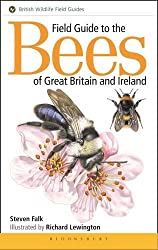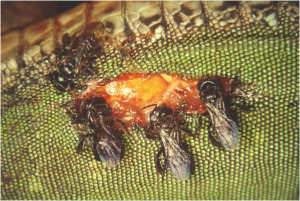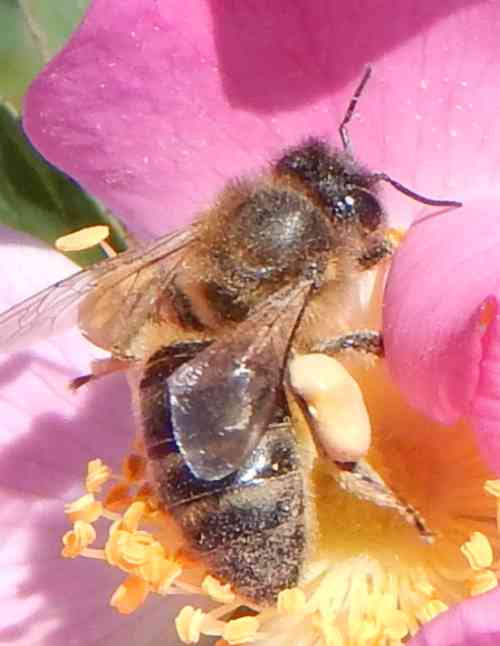Oil-collecting Bees - Macropis
Macropis, also known as oil-collecting bees, are a small genus with around 16 individual species identified worldwide1.
Macropis belong in the Melittidae bee family. They are univoltine (rearing one generation of offspring and having one flight period per year) and solitary.
An Introduction To Oil-collecting Bees - Macropis
These stout bees measure around 7-8mm. The females have distinctive pollen brushes on their sturdy hind legs.
Due to the oligolectic foraging habits of these bees, they are seen in restricted areas, depending on the availability of their target food source2.
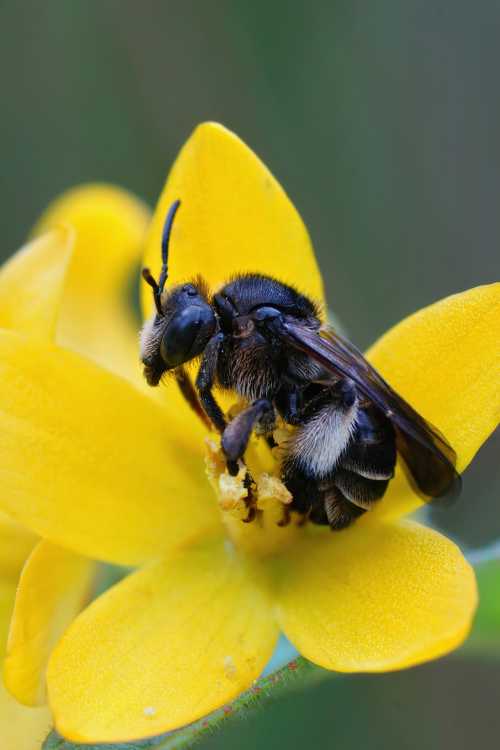 Macropis europaea, Yellow Loosestrife Bee. A female foraging. A species found in Britain and Europe.
Macropis europaea, Yellow Loosestrife Bee. A female foraging. A species found in Britain and Europe.As suggested by the common name, these bees gather floral oils along with pollen.
All species are specialists, gathering oils only from specific loosestrife flowers (Lysimachia).
Interestingly, the loosestrife (Lysimachia) on which these bees forage, do not produce nectar.
Instead, they have a dense covering of oil-producing glandular hairs at the base of the flower pistil (female organs of a flower, comprising the stigma, style, and ovary) and stamens of loosestrife flowers2.
Do Macropis bees ever consume nectar?
Despite their requirement for floral oils for lining their nests and feeding their larvae, adult bees also feed on nectar from a range of flowering plants2, including Ranunculus species and Apocynum androsaemilifolium4, thistles, embellifers, Alder Buckthorn, willowherbs and brambles3.
Males collect only nectar2.
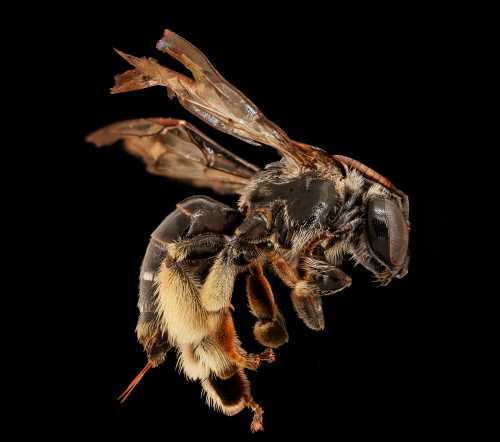 Patellate Yellow Loosestrife Bee, Macropis patellata, female.
This specimen was found by Ellison Orcott of the VA Heritage Group in the mountains of Virginia, US.
Patellate Yellow Loosestrife Bee, Macropis patellata, female.
This specimen was found by Ellison Orcott of the VA Heritage Group in the mountains of Virginia, US.How do Macropis gather floral oils, and why do they gather them?
Female oil-collecting bees have a combination of specially adapted hairs on the hind and front legs.
These hairs are a combination of short, fine, feathery hairs, and long, stiff unbranched hairs4. The hairs act like a mop, absorbing the oils in the flowers3.
The floral oils are combined with the pollen gathered from flowers, and transported back to the nest as food for larvae.
The oils are also used to line and waterproof nests, thus creating a greenish-yellow, waxy coating that ensures constant humidity for the pollen inside each nest cell, whilst preventing the entry of water2.
Research suggests floral oils are composed primarily of free fatty acids, and may also include traces of other nutrients, such as glucose, amino acids, carotenoids, saponins and phenolic glycosides4.
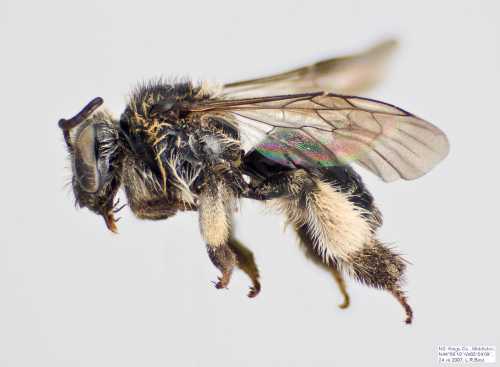 Macropis nuda female - image by The Packer Lab - Bee Tribes of the World via Wikipedia
Macropis nuda female - image by The Packer Lab - Bee Tribes of the World via WikipediaNesting habits
Nests often occur in elevated banks and slopes. Single or aggregations of nests occur in the ground in the form of shallow tunnels1. The use of the floral oil lining enables some Macropis species, such as Macropis europaea (the Yellow Loosestrife Bee)
to nest in damp soil, peaty and wetland areas3.
Mating habits
Although males only collect nectar (and not floral oils), males appear to patrol short routes around patches of loosestrife flowers, where they will usually stop and perch for a while on a nearby leaf or flower, whilst they await the arrival of foraging females2,4.
When a female arrives, a male pounces on her. The female may reject the potential mate by thrusting extended hind legs upward, then maintaining this posture for several minutes whilst continuing to forage2. Otherwise, mating may take place whilst resting on flowers4.
The males are attracted to females not only by female pheromones but also by appearance2.
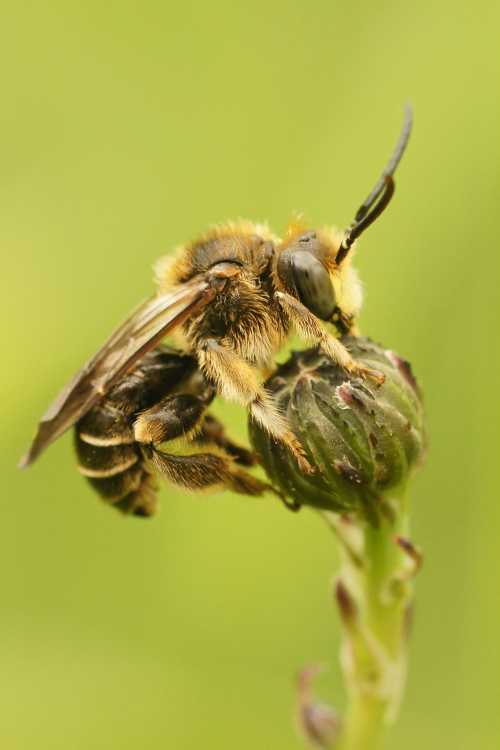 Yellow Loosestrife Bee, Macropis europaea, male.
Yellow Loosestrife Bee, Macropis europaea, male.Where are oil-collecting bees found?
The 16 identified species occur in temperate regions of the Northern Hemisphere1.
There are four species in the US and southern Canada1, and one species in Britain5.
Parasites and threats
Aside from habitat loss, a number of cleptoparasites target Macropis nests across the world.
A species found in the US, Macropis nuda is parasitized by Epeoloides pilosulus6 (commonly known as the "Macropis cuckoo bee").
Epeoloides coecutiens is known to target nests of Macropis fulvipes and Macropis europaea in European regions6.
References
1. The Bees In Your Backyard - A Guide To North America's bees by Joseph S Wilson and Olivia Messenger Carril.
2. Pekkarinen, A., Berg, Øistein, Calabuig, I., Janzon, L.- Åke, & Luig, J. (2003). Distribution and co-existence of the Macropis species and their cleptoparasite Epeoloides coecutiens (Fabr.) in NW Europe (Hymenoptera: Apoidea, Melittidae and Apidae). Entomologica Fennica, 14(1), 53–59. https://doi.org/10.33338/ef.84171
3. Falk S, University of Oxford and Wytham Woods Genome Acquisition Lab, Darwin Tree of Life Barcoding collective et al. The genome sequence of the yellow loosestrife bee, Macropis europaea Warncke, 1973 [version 1; peer review: 1 approved with reservations]. Wellcome Open Res 2022, 7:110 (https://doi.org/10.12688/wellcomeopenres.17787.1)
4. Cane, James H., et al. “Foraging, Grooming and Mate-Seeking Behaviors of Macropis Nuda (Hymenoptera, Melittidae) and Use of Lysimachia Ciliata (Primulaceae) Oils in Larval Provisions and Cell Linings.” The American Midland Naturalist, vol. 110, no. 2, 1983, pp. 257–64. JSTOR, https://doi.org/10.2307/2425267. Accessed 9 Sep. 2022.
5. Field Guide to the Bees of Great Britain and Ireland by Steven Falk.
6. Bogusch, Petr. “Biology of the Cleptoparasitic Bee Epeoloides Coecutiens (Hymenoptera: Apidae: Osirini).” Journal of the Kansas Entomological Society, vol. 78, no. 1, 2005, pp. 1–12. JSTOR, http://www.jstor.org/stable/25481801. Accessed 9 Sep. 2022.
If you found this page helpful or interesting, I'd really be grateful if you would share it with others - if not this page, perhaps another, such as Gardening For Bees.
Thank you so much :) .
